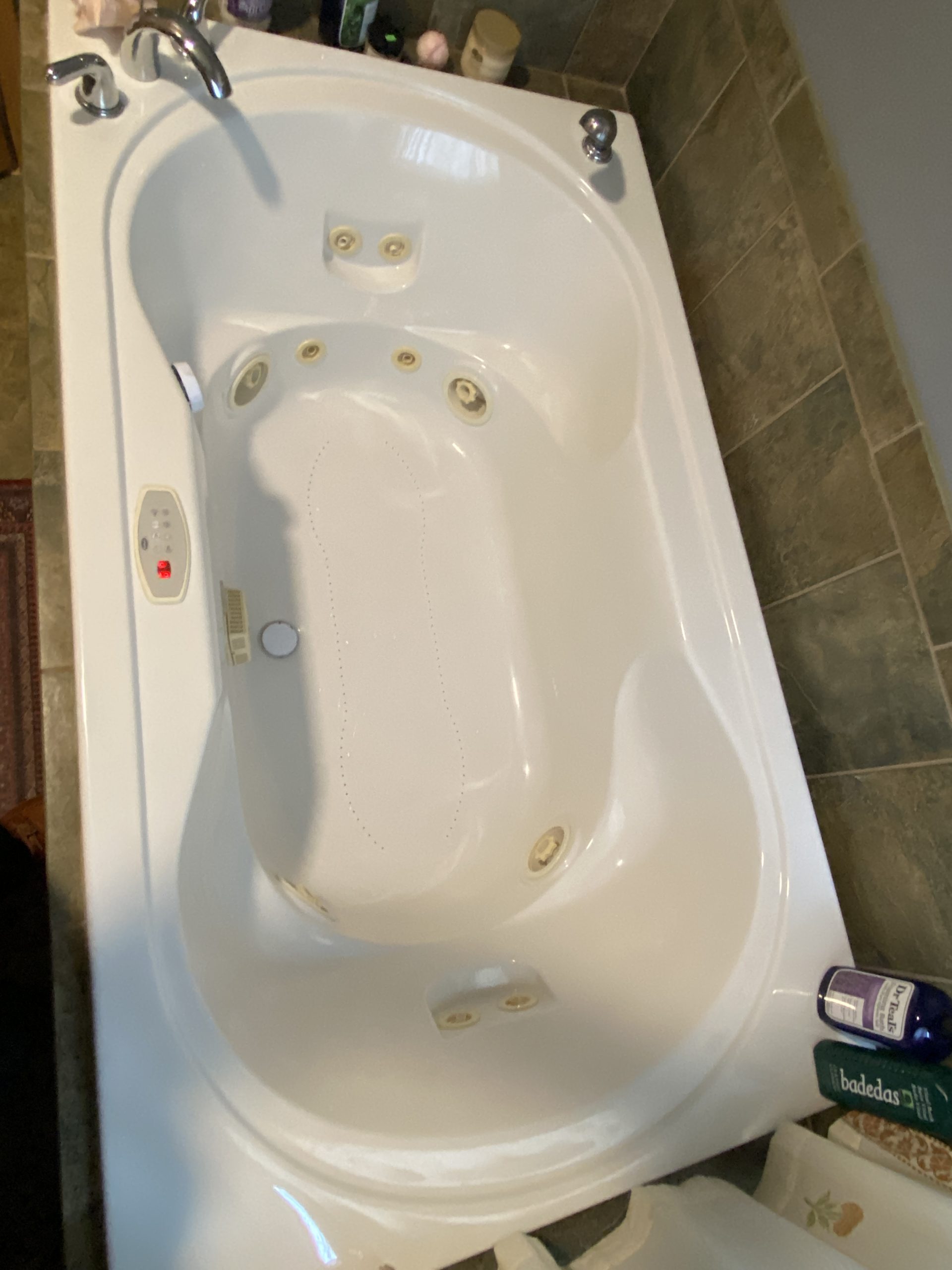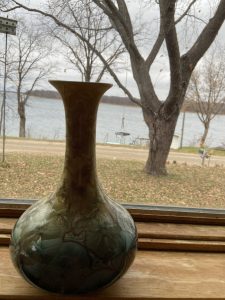
Karen, seeking a new life, had fled from her family and friends to Kyoto, Japan. She fell into equally bad relationships in the expat community. I have tried to explain her process of separating from me. She joined a potter’s commune on the island of Shikoku where she eventuality became a renowned potter.
One day, after dinner with her troublesome lover, Karen returned to her apartment and made a decision while immersed in her ofuro, Japanese bath. She looked at her body under the water. Small bubbles on her legs desperately held on until the movement in the water broke them away, rising to the surface and disappearing into the humid air of the bathroom. The bubbles refracted and bent the light displacing her reality with an image slightly apart from herself. As she lowered herself in the tub her body felt terrible heat. Slowly she pushed herself against the scorching cushion of the water. A further attack of hot water occurred at her waist where the inlet for the hot circulating water occurred.
Eventually she had to turn it off. Sitting quietly, she could feel the different temperatures recede and extend over her body. She began to monitor these waves as one would apply glaze to a pot and proceed with an appropriate firing. She was not her body. That organism would grow, change, die without her. Her brain would never feel the heat or anchor a bubble. Each part of her had a significance of its own, its own law of nature.
Stretching her body out as far as it could go, she watched the bubbles rise to the top. More adjusted to the temperature she began to think of her life in Japan. She had come to escape. Yet again, she was drowning. Not by her parents, or her college boyfriends, but rather her own loneliness. Under the water, watching her bubbles launch off from her body and disappear into the steamy room gave her a sense of detachment and separateness. Once again, she decided to find a refuge from me and the other expats.




Wow, Richard, the metaphor of Karen’s body in the bubbles, refracting the light, is exquisite. How she thinks and determines to leave you behind is Zen-like.
You seem to have impersonated Karen and her internal thoughts very well—did she explain all that to you? I hope the epiphany in the tub led her to a place with less loneliness. It sounds as if it led to some remarkable artistic success in pottery even though it removed her from some level of friendship with you.
This is quite a well written piece that drew me in and had me–almost–right there in the tub full of hot water with Karen. Good description is what made it such a strong piece. But it also leads me to ask: how could you know so many of these details without being there? Did she recount them to you, minute-by-minute? Or is this an voyage intothe imaginary?
Both!
Richard, as always I’m in awe of your descriptive powers, but what an unsettling story about your friend.
Years ago I took a pottery class at the 92St Y and found it such a creative endeavor. I hope Karen’s beautiful pottery gave her the joy that may have countered some of her despair.
Dana here is the end (last half) of her story
still needs editing
* * * * *
Karen found an apprenticeship with the famous potter, Oyaki whose kiln was on the large inland sea island named Shikoku. Her new home was just a ditch of a town etched in a groove between two small mountain ranges. Her first few months were spent in the tedious ritual of potting. Oyaki’s pottery was known for combining grace with large-scale vases. Usually shoulder-high, they looked like one of Dicken’s characters, with a small base, a bulging middle, a thinning neck, and a gaping mouth.
Karen had to learn to identify the proper vein of soil by walking over and observing the hillsides. Sometimes she would stay overnight at a local temple. When she discovered an appropriate cache of rocks and soil, she dug them out and loaded a truck. She would dump her discovery near the water hammer which would pound the clay. A bucket on one side of a teeter-totter fills up the water that is flowing from a stream. Once it fills up, it outweighs the rock on the other end.
The rock lifts and at the same time the bucket drops to the ground, spilling its contents. The rock then crashes down onto a pile of wet clay. In between the rise and fall of the rock, Karen had to quickly place a new bulge of clay upon the platform beneath the plunging rock. It was in this motion that Karen was elevated by the powers of Zen. She felt hypnotized by the rhythm, fearful that the slightest deviation could result in a crushed hand, a crushed foot, or even a crushed head.
Karen not only had to watch the rock, as well as the consistency of the clay. Once it was free of large rocks and stones and had obtained the feel of unleavened dough, she could carve out slabs several inches thick and several feet long. Reducing the amount of water used with the pounding, she would beat out all the air bubbles. These strips would soon become the base and coils.
Karen enjoyed the physical exertions. The search for the materials and the refinement of the clay gave her the opportunity to enjoy her own body and to watch the creation of meaningful form from nothing. This part of the job was all public and open. Once the coils had been put in place, the task became private and dark. Karen had to learn how carefully to reach down from the outside into the dark pit of the pot to smooth out the interior. Reaching into the dark hole and touching the bottom for the last time, Karen would have to withdraw a little more each time. As she stroked and sealed the sides of the cavity for the last time, she felt like she had been expelled from the womb of her own creation. Head down in the darkness, she would pound her hands, but her body had to remain still producing an overwhelming tension.
More months passed before she learned how to create a mouth. Oyaki had told her the principles, but she did not learn easily. “Unlike a person’s mouth,” he constantly and patiently told her, “The pot’s mouth must both swallow and dispense its liquids and refreshments. The opening must be able to give and receive. If it can only consume, then it is a greedy pot. If it splashes out indiscriminately, then it is an ill-mannered pot.” But Karen found that the function was not enough. The style had to be appropriate.
For some pots, the mouth is curled over like the rolled-up sleeve on a Kabuki robe. In others, it is braided like the belt of a Japanese sumo wrestler. Karen, in contrast, finally produced a mouth that reminded her of the center of a sea anemone that circulated water and nutrients into and out of its system.
The dreams had begun immediately after she submerged herself inside the hollow of the finished pot. Her meditations were broken by sleep, and her sleep was interrupted by visions of snakes. The snakes coiled on her arms, around her wrists, and fled quickly behind her back. They were not aggressive or threatening. They questioned her. Why was she in the path of their transit? Could she not move away and let them slither on their snake-way?
For months she was in these dreams. Finally, out of desperation, she approached Oyaki. “The snakes are a test. They are asking you for something. What could it be?” Oyaki was silent. The two of them sat in the Zen posture until the sunset. Oyaki burst through the silence: “Tonight, bring the snakes to me.”
Again, that evening, Karen squeezed into the lip of the pot. Inside she had placed a small tatami or bamboo mat, a thermos of hot water, and a cover. Sitting cross-legged she began the Zen breathing exercises and began to clear her mind. Instead of soon falling asleep as had been her habit for over six months, she was wide awake. The moon moved across the archipelago of Japan’s island-states. The ragged and eerie topography of Shikoku bounced the moon’s rays into cold and spectacular canyons and off cliffs and ridges. Snakes entered the pot, moved around, slid off her, and resumed their trek. What were they looking for?
She knew the snake symbolized protection. Elaborate body tattoos featured snakes wrapped around arms, legs, or resting on one’s body.
Karen arched her body against the confines of the pot. “Hurry up and sleep.” She urged herself on. Soon the futility of trying to force her rhythms into sleep broke out in anger, and her body was in sweat. In a last effort of irritation and exasperation she stretched and arched, and suddenly fell asleep.
The violence of her falling asleep had scared away the strongest snakes. For only a small, quiet snake appeared. It crawled onto Karen’s hand. It made no attempt to get away, to pursue its own course.
“How can I bring such a small thing to Oyaki? Wouldn’t he just laugh? ‘Where are the large ones?’
“What if I ask Oyaki not only to interpret the reason for having snakes but also to describe the snake itself?”
After a time of silence, Karen realized it was not a test for her, but a test for Oyaki. Karen cupped the snake’s body in her hand, holding its head between her fingers and thumb. Her thumb revealed the impression of creases from the snake’s scales. She approached Oyaki while holding the snake behind her back, out of his sight.
“Good evening.” Oyaki bowed deeply from his Zen sitting posture. “Good evening master. I have brought you what you asked for. Please tell me if it is living or dead.”
Karen did not want to come as an apprentice seeking wisdom. It was her turn to ask the questions, to make the test. If Oyaki answered that the snake was living, she could easily crush its head with her thumb; if he answered that it was dead, she would place it on the mat in front of him, letting it slither away.
Oyaki stared at her. Usually, he did not look at her straight in the eyes. This time he was searching. He had not been confronted before by a woman. And by a foreigner at that.
Before the dawn, Oyaki smiled. He had reached enlightenment. “Karen, you are no longer my deshi (apprentice), you are a master potter and a Zen teacher. The answer to your question is in your hands.”
By the time the issue of Japan Unaware with the article on Karen was distributed in tourist centers such as the National Japan Tourist Bureau, and elite hotels of Tokyo and Kyoto, Karen had already left Shikoku and Japan. She returned to the East Coast. There she built her own kiln, taught classes in pottery, translated articles on Japanese crafts, and interpreted for Japanese businesspeople. Her unique pots with the design of a small snake on a thumbprint just behind the head became popular.
A beautifully written but painful story.
Wonderfully told. Evocative. Frightening.
Thank for including the ending. It was absolutely not what I expected!